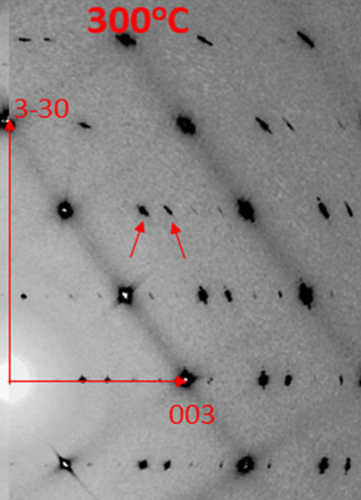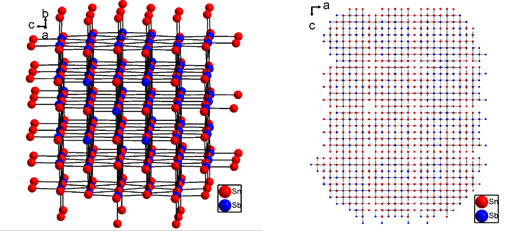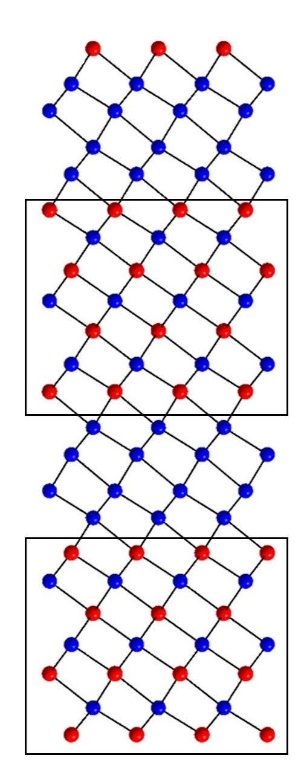The structures in the Sn – Sb phase diagram recently regained interest due to their occurrence in lead free solder. To predict the stability of a solder joint, all possibly appearing intermetallic compounds at this joint need to be considered for their physical properties. While all other structures in the phase diagram are known, the predicted Sn3Sb2 high temperature structure has been elusive.
This structure has been determined by a team from Lund University, using X-ray diffraction at the CRISTAL beamline.
The Sn3Sb2 high temperature structure has been anticipated to exist between 250oC and 324oC, while below 250oC it inevitably transforms to a twinned form of the low temperature structure (Sn3Sb4). Hence no inspection of the high temperature structure at room temperature is possible. Even if the sample is heated back to temperatures above 250oC, measurements only show the twinned low temperature structure, which on closer inspection, could be attributed to the loss of tin from the sample. Additional tin was therefore added and upon heating the sample absorbed the supplementary tin like a sponge and transformed to the predicted high temperature structure.
The structural study itself was complicated by the fact that Sn and Sb are neighbours in the periodic table and hence have very similar scattering factors for X-rays, which makes distinguishing them in standard diffraction experiments very difficult.
To enhance the contrast between these two elements, the wavelength of the synchrotron beam was accurately adjusted to 0.42484 Å, close to the absorption edge of Sn. Close to their absorption edge, elements start to fluoresce. In that case, the fluorescent Sn atoms behave as if they had less electrons contributing to the diffraction of the X-ray beam. The contrast between Sn and Sb is therefore increased. Furthermore the two compounds involved are incommensurately modulated.
A basic property of usual crystals is their translational symmetry properties: for a (perfect) crystal, the description of the atomic structure is reduced to the description of the positions of atoms within a very small volume, called the unit cell. The periodic repetitions of this unit cell along three directions of the space (i.e; the translational symmetry properties) generate the lattice of the structure and therefore the whole macroscopic crystal. These translational properties manifest themselves as strong reflection spots in X-ray diffraction patterns. In the case of our ‘tin sponge’, additional (weak) diffraction spots appear between the stronger spots (cf. red arrows on Fig1), whose origin belongs to what is generally called a substructure within the crystal. These additional spots represent a modulation of the substructure which causes the inherent translational symmetry properties of the substructure lattice to be lost (broken).

Figure 1: Reciprocal lattice reconstruction of single crystal X-ray diffraction of Sn4Sb3 at 300°C. Incommensurate reflections are marked by the red arrows (first order satellites).
If the additional spots are located at simple fraction distances of the stronger spots distances (e.g. 3/5) the resulting broken symmetry is said to be commensurately modulated. If the fraction is not simple (e.g. 0.62531), the broken symmetry is said to be incommensurately modulated. It was long demonstrated that translational symmetry properties could however be recovered if the crystal is described in a space with more than 3 dimensions (crystallography at 3+N dimensions).
Sn3Sb4 has a rather small degree of incommensurability and can therefore be treated in (3+1) dimensions, but Sn3Sb2 has an unusually high degree of incommensurability and therefore has to be treated in (3+4)D. Such highly incommensurate structures are extremely scarce and highly fascinating.
The resulting crystal structure shows cubes of 7x7x7 atoms with alternating Sn and Sb. These cubes are connected by a layer of pure tin in all directions (Fig2).

Figure 2:
Left: zoom into one of the clusters showing the almost perfect 7x7x7 NaCl type structure.
Right: arrangement of clusters interleaved by pure Sn. Blue spheres denote antimony and red spheres denote tin.
The Sn - Sb phase diagram has been investigated in a previous paper, leaving only the above described structure unknown. Other compounds found in this phase diagram comprise the stoichiometries Sb2Sn, SbSn and Sb3Sn4, and also pure Sb is present. Those compounds are built from slabs that contain seven layers of alternating Sn and Sb and these slabs are interleaved by varying amounts of pure Sb (Fig 3). All the structures are incommensurate..

Figure 3: The structure of Sb2Sn illustrating the 7x7 layer slabs interleaved by pure Sb.
Conclusion
The high temperature phase Sn3Sb2 is an extraordinary example of a structure involving a (3+4)D modulation, neighbouring elements and an unpreventable phase transition that includes tin loss. These obstacles could all be overcome, leaving a cluster like compound that fits perfectly well with the other structures in the Sn – Sb phase diagram.
